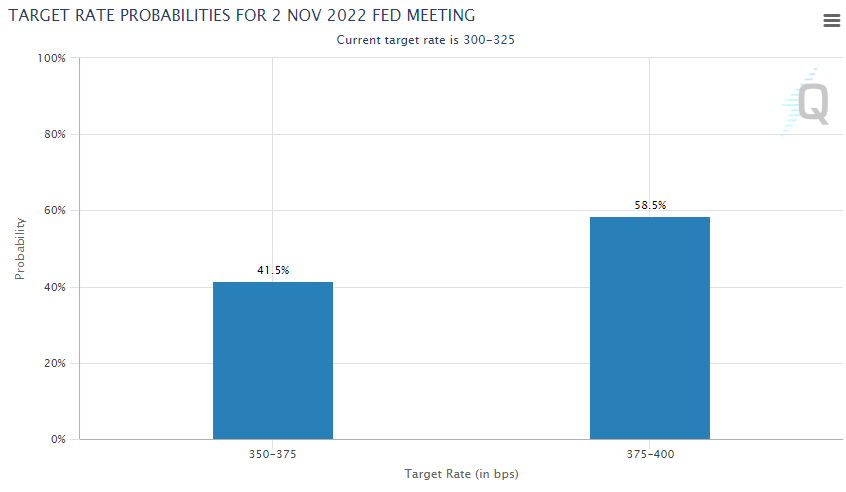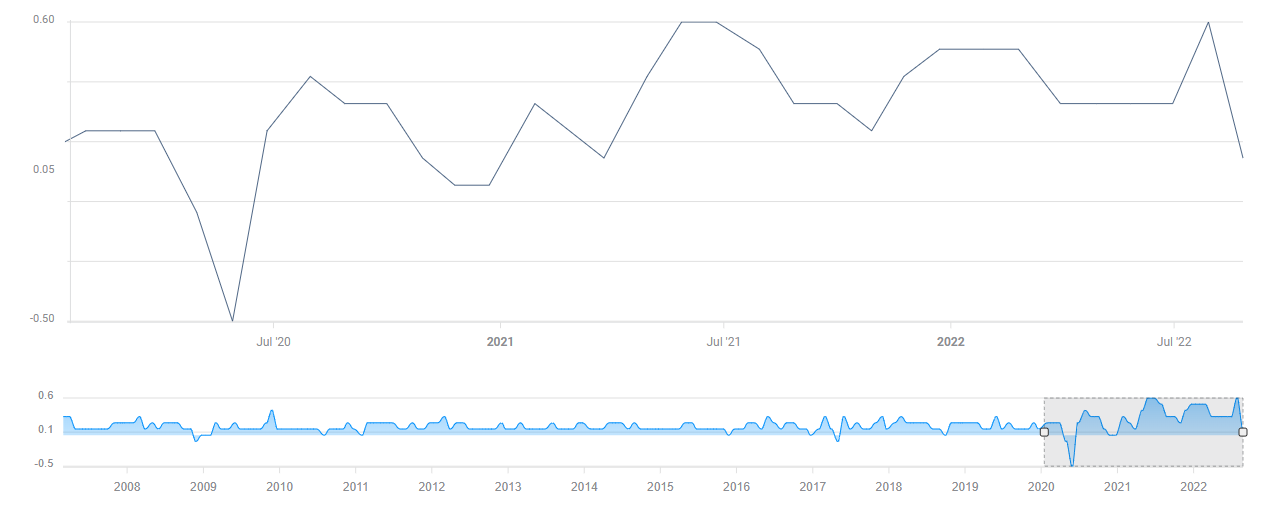- Monthly core PCE inflation is expected to rise by 0.5% in August.
- Markets see a more-than-50% chance of a 75 bps Fed hike in November.
- A soft PCE inflation report is likely to trigger a downward correction in DXY.
The US Bureau of Economic Analysis will release the Personal Consumption Expenditures (PCE) Price Index data, the US Federal Reserve’s preferred gauge of inflation, for August on Friday, September 30.
On a yearly basis, the PCE inflation and the core PCE inflation, which excludes volatile food and energy prices, are forecast to rise to 6.6% and 4.7%, respectively.
After the US Bureau of Labor Statistics announced on September 13 that the Core Consumer Price Index (CPI) climbed to 6.3% on a yearly basis in August from 5.9% in July, the US Dollar Index (DXY) gained 1.5% on the day. In response to strengthening inflation, the US central bank raised its policy rate by 75 basis points to the range of 3-3.25% eight days later. Additionally, the Fed’s updated Summary of Economic Projections (SEP) showed that policymakers’ median view of the Fed's policy rate at the end of 2023 rose to 4.6% from 3.8% in June's dot plot. In turn, the DXY extended its rally and reached its highest level since May 2002 at 114.78 earlier in the week.
Market implications
Since the DXY’s upsurge witnessed in the second half of September was fueled by the hot August CPI data, the market reaction to a stronger-than-expected PCE Price Index could remain short-lived. The Fed has already responded to rising price pressures in August and the September CPI data report is likely to have a more significant impact on the market pricing of the next Fed rate decision rather than August PCE prints. According to the CME Group’s FedWatch Tool, the probability of one more 75 bps rate increase in November currently stands at 58.5%.
Source: CME Group
Market participants will pay close attention to the core figures. The 10% decline witnessed in crude oil prices in August is likely to limit the potential increase in the headline PCE inflation. More specifically, the monthly core PCE Price Index will be the key figure to watch because it will not be distorted by base effects. The market expectation is for the monthly core PCE inflation to rise by 0.5% in August following July’s 0.1% increase. A reading above 0.5% could help the dollar outperform its rivals but it is unlikely to trigger a significant bullish rally. Even if that were to be the case, profit-taking ahead of the weekend could cause the currency to erase any potential gains.
Core PCE Price Index (MoM) chart
On the other hand, the dollar’s overbought conditions and the absence of a healthy correction suggest that a soft monthly core PCE inflation print between 0% and 0.3% could translate into a powerful reaction. Investors have been struggling to find an excuse to give up on dollar longs and reassess the situation before September inflation and employment data. Ideally, Wall Street’s main indexes would rise sharply in that scenario and result in a deep correction in the DXY.
Information on these pages contains forward-looking statements that involve risks and uncertainties. Markets and instruments profiled on this page are for informational purposes only and should not in any way come across as a recommendation to buy or sell in these assets. You should do your own thorough research before making any investment decisions. FXStreet does not in any way guarantee that this information is free from mistakes, errors, or material misstatements. It also does not guarantee that this information is of a timely nature. Investing in Open Markets involves a great deal of risk, including the loss of all or a portion of your investment, as well as emotional distress. All risks, losses and costs associated with investing, including total loss of principal, are your responsibility. The views and opinions expressed in this article are those of the authors and do not necessarily reflect the official policy or position of FXStreet nor its advertisers. The author will not be held responsible for information that is found at the end of links posted on this page.
If not otherwise explicitly mentioned in the body of the article, at the time of writing, the author has no position in any stock mentioned in this article and no business relationship with any company mentioned. The author has not received compensation for writing this article, other than from FXStreet.
FXStreet and the author do not provide personalized recommendations. The author makes no representations as to the accuracy, completeness, or suitability of this information. FXStreet and the author will not be liable for any errors, omissions or any losses, injuries or damages arising from this information and its display or use. Errors and omissions excepted.
The author and FXStreet are not registered investment advisors and nothing in this article is intended to be investment advice.
Recommended Content
Editors’ Picks

Gold moves to record highs past $3,340
Gold now gathers extra steam and advances beyond the $3,340 mark per troy ounce on Wednesday, hitting all-time highs amid ongoing worries over escalating US-China trade tensions, a weaker US Dollar and lack of news from Powell's speech.

Australian Dollar receives support from improved global risk mood, US Retail Sales eyed
The Australian Dollar extends its winning streak against the US Dollar for a sixth consecutive session on Wednesday, with the AUD/USD pair holding firm after the release of Australia’s Westpac Leading Index. The index’s six-month annualised growth rate eased to 0.6% in March from 0.9% in February.

EUR/USD remains in a consolidative range below 1.1400
EUR/USD navigates the latter part of Wednesday’s session with marked gains, although another test of the 1.1400 level remained elusive. The strong bounce in spot came on the back of a marked move lower in the US Dollar, which remained apathetic following the neutral stance from Chair Powell.

LTC, BCH, DOGE Price Analysis: Nine proof-of-work coins rally on Nvidia’s $5.5 billion charge
Litecoin, Bitcoin Cash, and Dogecoin experienced significant rallies today, as nine proof-of-work cryptocurrencies surged following Nvidia's announcement of a $5.5 billion charge due to U.S. restrictions on its AI chip sales to China.

Future-proofing portfolios: A playbook for tariff and recession risks
It does seem like we will be talking tariffs for a while. And if tariffs stay — in some shape or form — even after negotiations, we’ll likely be talking about recession too. Higher input costs, persistent inflation, and tighter monetary policy are already weighing on global growth.

The Best brokers to trade EUR/USD
SPONSORED Discover the top brokers for trading EUR/USD in 2025. Our list features brokers with competitive spreads, fast execution, and powerful platforms. Whether you're a beginner or an expert, find the right partner to navigate the dynamic Forex market.

